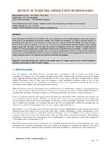Mostrar o rexistro simple do ítem
Review of warm mix asphalt new technologies
| dc.contributor.author | Martínez-Díaz, Margarita | |
| dc.contributor.author | Pérez Pérez, Ignacio | |
| dc.contributor.author | Romera, Luis | |
| dc.date.accessioned | 2016-12-09T19:42:17Z | |
| dc.date.available | 2016-12-09T19:42:17Z | |
| dc.date.issued | 2013 | |
| dc.identifier.citation | Martinez-Diaz, M., Perez-Perez, I., Romera-Rodriguez, L.E.. (2013). REVIEW OF WARM MIX ASPHALT NEW TECHNOLOGIES. DYNA, 88(3). 334-343. DOI: http://dx.doi.org/10.6036/5410 | es_ES |
| dc.identifier.uri | http://hdl.handle.net/2183/17743 | |
| dc.description.abstract | [Abstract] Since the signature of the Kyoto Protocol, efforts in the search of processes to slow climate change down have been increased. In the case of the manufacture of bituminous mixtures, new products and procedures that allow a significant reduction of greenhouse fumes emissions and of consumption of energy resources, keeping the demanded benefits, have been developed. However, there is still some reluctance to use them, due to the ignorance of manufacturers about the changes needed in asphalt plants to adapt their technology, as well as about the economic consequences of their use. Therefore, this paper shows an analysis of the key technologies used to manufacture mixtures at low temperature that exist nowadays. Changes in plants to incorporate these new technologies are detailed, and an economical and environmental balance that compares the manufacture of these mixes with the traditional hot mixes is carried out. Everything with the aim of encouraging producers and Authorities to employ these new products, both effective, environmentally sustainable and profitable | es_ES |
| dc.description.abstract | [Resumen] Desde la firma del Protocolo de Kioto se han incrementado los esfuerzos en la búsqueda de nuevos procesos que frenen el cambio climático. En el caso de la fabricación de mezclas bituminosas, se han desarrollado nuevos roductos y procedimientos que permiten una disminución significativa de las emisiones de gases de efecto invernadero y del consumo de recursos energéticos, conservando las prestaciones requeridas. Sin embargo, todavía existe cierta reticencia al uso de los mismos, debido al esconocimiento de los fabricantes sobre los cambios a incorporar en las plantas asfálticas para adaptar su tecnología, así como de las onsecuencias económicas de su empleo. Por lo tanto, en este trabajo se muestra un análisis de las principales tecnologías de fabricación de mezclas bituminosas a baja temperatura presentes en la actualidad. Se detallan los cambios a realizar en las plantas para poder incorporar estas nuevas tecnologías y se realiza un balance económico y ambiental que compara la fabricación de estas mezclas con las tradicionales fabricadas en caliente. Todo ello con el objetivo de alentar a los productores y Administraciones a que empleen estos nuevos productos, a la vez eficaces, ecosostenibles y rentables. | es_ES |
| dc.language.iso | eng | es_ES |
| dc.publisher | Dyna | es_ES |
| dc.relation.uri | http://www.revistadyna.com/Articulos/Ficha.aspx?Cod=5410&CodArt=6FB9834F-9990-42E9-B413-153E988C8218 | es_ES |
| dc.subject | Sustainable development | es_ES |
| dc.subject | Half-warm mix asphalt | es_ES |
| dc.subject | Warm mix asphalt | es_ES |
| dc.subject | Asphalt plants | es_ES |
| dc.subject | Industrial adaptation | es_ES |
| dc.subject | Emissions | es_ES |
| dc.subject | Consumptions | es_ES |
| dc.subject | Costs | es_ES |
| dc.subject | Life-cycle analysis | es_ES |
| dc.subject | Desarrollo sostenible | es_ES |
| dc.subject | Mezclas templadas | es_ES |
| dc.subject | Mezclas semicalientes | es_ES |
| dc.subject | Plantas asfálticas | es_ES |
| dc.subject | Adaptación industrial | es_ES |
| dc.subject | Emisiones | es_ES |
| dc.subject | Consumos | es_ES |
| dc.subject | Costes | es_ES |
| dc.subject | Análisis de ciclo de vida | es_ES |
| dc.title | Review of warm mix asphalt new technologies | es_ES |
| dc.title.alternative | Revisión de las nuevas tecnologías de fabricación de mezclas bituminosas a baja temperatura | es_ES |
| dc.type | info:eu-repo/semantics/article | es_ES |
| dc.rights.access | info:eu-repo/semantics/openAccess | es_ES |
| UDC.journalTitle | Dyna | es_ES |
| UDC.volume | 88 | es_ES |
| UDC.issue | 3 | es_ES |
| UDC.startPage | 334 | es_ES |
| UDC.endPage | 343 | es_ES |
| dc.identifier.doi | http://dx.doi.org/10.6036/5410 |
Ficheiros no ítem
Este ítem aparece na(s) seguinte(s) colección(s)
-
CITEEC-CGM - Artigos [93]






